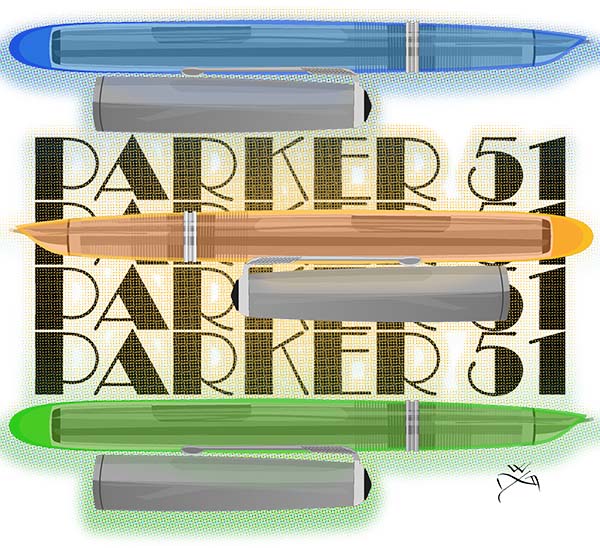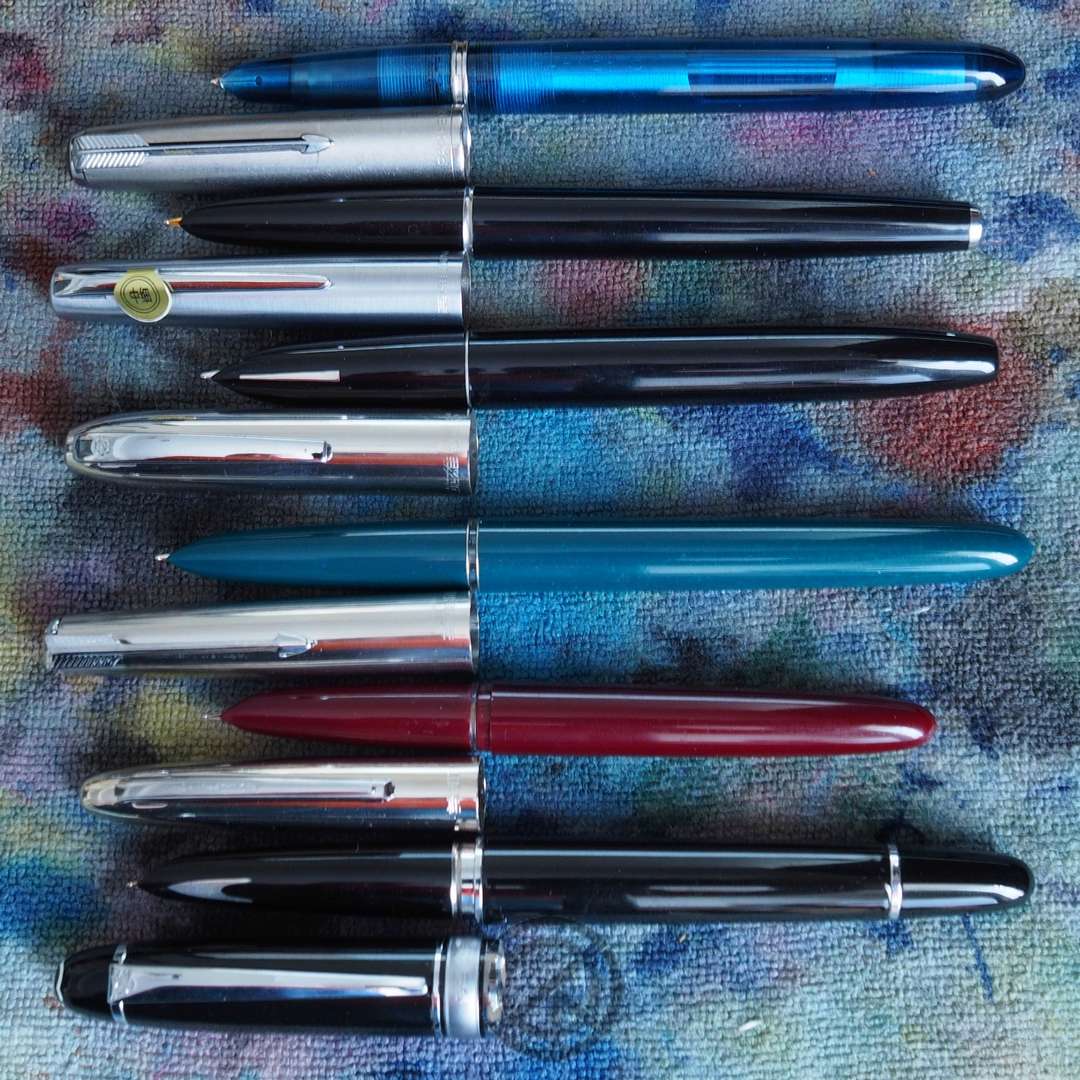
[click on the image for wearable media!]
The Parker 51, Cadillac of the Sky
No, that's the P51 Mustang ... same era, but this pen only took it's design from a plane or a rocket. The Parker 51, is most likely the best known fountain pen, ever. A lot were sold and you so you can still find them today. But their command is in collector's hands at this point. That's the Parker 51, first offered to the public in 1940/1. The model name was one of those coined because it sounded good, chances that it tied in to 51st anniversary of the company probably helped as well? That distinctive shark mouth covered nib section, was supposed to look like an aircraft in it's sleek style. Interestingly a decade later, fighter jets of the 1950's had similar air intakes. The pen mimic'd a jet turbine, before jet turbines were even a topic.
The original models didn't have the familiar covered squeeze bulb fill system. They relied on the Parker's Vacumatic diaphragm pumping system. During the war Parker Pens were austere with their parts material. And metal was in short supply. The Vacumatic during the war was made with celluloid parts replacing metal internals. Post WWII the Parker 51 came to be the complete pen design that is familiar to most. Prior to this particular pen, fountain pens were traditional in design and placement. Most pens had the same approach, differences generally relied on a specific ink filling design. The nib end of the majority of pens was based on the same exposed nib and feed tucked into a section.
The Parker 51 broke that mould as the first covered nib fountain pen and not just a marketing revamp. The idea was to keep the pen's ink fluid until it was drying on the page. Until then, it would remain static and ready. The pen itself had an advanced improvement in fountain pen use. Fountain pens at this time were finding it harder to compete with relatively cheap and functional ballpoint pens. Which besides offering savings were both instant writing and clean. Generally speaking they didn't leak and worked without preparation. They spoke of the future. Modern placement.
The Parker 51 took this battle directly in hand. Here was a pen that looked like the space age, before it even happened. After this introduction. All major brands had to create their own covered nib designs to catch up. The Aerometric feed system. Was more complex than any previous fountain pens. It also performed better. The beauty of that pen's ink delivery was so good, that you could pick up a pen that had been sitting for months and it would write instantly. Ink at the ready. Even a ballpoint in the day, that sat so long could be a challenge to get started.
Without a lot detail. The 51 had a much different internal design. First the nib was tubular in shape. Smaller diameter too. This sort of harks back to the origins of a bird quill which is also a tube shaped nib. The feed in a 51 has a breather tube in the back and this connects to the nib flow slot under the top of the nib. What is different here is that outside of the nib is a new part called a container. This is a high surface area [fins] addition that will contain a large amount of ink around both the nib and internal feed. It's design keeps the nib end of the pen wet and ready to intact the capillary action that flows in all pen feed systems, without flooding, and even in long storage scenarios. The pen is ready to write. Often gravity will defeat any liquid ink pen stored upright as that ink flows back to the lowest position, so the nib and feed dry out. Worse yet a design that can't contain the stored ink due either storage position, or environmental shifts. The Parker 51 overcomes this problem with it's distinct engineering.
The performance of the Parker 51 helped build the brand's popularity by it's performance. The style and look of a 51 became ubiquitous as it was the goto product of it's age. A retail identifier. Today, Parker 51s are vintage pens and thus collector's items. To buy a new fountain pen using this remarkable design, you have to rely on some of the Asian pen companies that still make the pen off of old original tooling. Not that all covered nib pens are Aerometric feed systems in design these days either. The look of the Parker 51 has been mimicked over the decades while the internal workings of such look-alike pens often use far simpler feeding systems. But there are viable clones of the 51 that accurately replicate the way the 51 worked in all but brand ID. Hero makes a variety of pen models based on the original design. The parts and design use old Parker 51 manufacture tooling. The Hero pens are made in a range of prices. So their construction can be much cheaper than the originals. You can also find models that are made at the same QC level of the original pen.
Here in the image is a top down sample of 51s. At the top is a 1950s Parker 51 Aerometric. The unusual body and section of clear resin is a custom design by the artist Argentine based, Ariel Kullock. These exclusive bodies were made up until 2015 and are now NLA.

The Hero 100 Classic is a dead-ringer. The missing Arrow styled clip is about the only part of it that doesn't match the original, that and Hero branding. Otherwise this is a 14K Gold Nib modern version of the 51. And it's quality matches the original closely to make it a lifetime quality pen.
The Hero 565 is probably thought of as a modern variation of the original It's taken the 51 concept and tuned it for modern tastes. Slightly larger in diameter, it uses more plastic parts replacement but the biggest cost savings is the steel nib. Gold nibs always boost the cost of any pen, because you have to pay for the value of the gold scrap value above and beyond the rest of the pen. Cheaper Hero's have an ink slot window by using clear plastic couplers vs steel. Steel is stronger, but the window does tell you how much ink is in the pen?
The affordable Hero 616 has the originals looks. This pen retains the fletched arrow style clip. Made with cheaper materials, aluminium pump cover and a steel vs gold nib. It still writes and performs well. This model is dimensionally accurate to the original. (In today's eyes, the original Parker 51 is a slim, average sized pen.)
One of my recent favourites because I don't know of a cheaper pen that works as well as this one. The Hero 366. It's a "demi" sized 51 being quite short. In fact this is part of it's benefit. You can include this pen into any situation, it takes up no room I have small 2ml sample vials. These can be filled with various colours of ink. A whole palette if you please. These and this little pen which can be filled and emptied directly to these vials can make up the tiniest little travel pack, that takes up no room and no weight! The simple bulb fills and empties with ease. The steel nib is smooth and precise. The pen is small, but not too small to comfortably work with and has decent length when posted.
The stylish Hero 2015 100C was a short run, High-end, almost a hybrid design? Hero's style approach here seemed to beg the question, if Montblanc and Parker got married, what would their child look like? Outside the pen has a stoic, Meisterstuck body and cap design. The traditional EU fountain pen look and heft. Hero's logo substituting the snowy peak at the top. removing the clutch slip cap and inside you are looking at the classic 51 in all respects down to the internal working Aeromatic. Parts that are made at a quality you would find in the original. (This pen is priced within the realm of securing an original Parker 51 ... and with it's short exclusive run, it's more rare!)
The Hero 007 [no image here] is a longer, thinner variation. It looks less like a Parker, but internally, you again get the benefits of an Aerometric designed pen. Steel nib and cheaper materials. It's another great writing, while affordable pen.
If you go to my trademe auctions you can find all these but the two most expensive mentioned. watersoluble TradeMe PEN Listings

